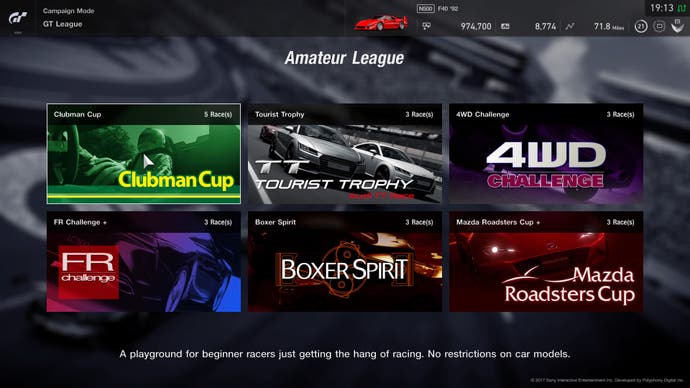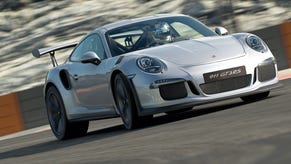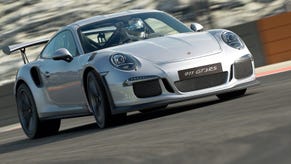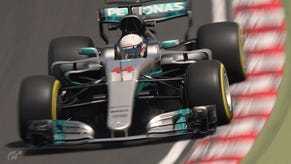Gran Turismo Sport's update brings back the game you thought you wanted
Grinding gears.
On 22nd December, as a Christmas present to Gran Turismo players - and 20 years to the day since the first game in the series launched in Japan - developer Polyphony Digital released a major update for Gran Turismo Sport. Alongside some Christmas menu music done in the series' trademark lounge-jazz style, the update added a colourful selection of a dozen new cars, including legendary street-legal racecar the Ferrari F40, iconic surfer transport the Volkswagen Samba Bus, and two models of Nissan Skyline GT-R - the 90s/00s turbo hero whose success and reputation owe a great deal, like several other Japanese sports cars of its generation, to its appearances in Gran Turismo games.
The headline addition, though, was the GT League. This new campaign mode more closely resembles the classic Gran Turismo single-player experience than anything else in GT Sport. Indeed, with the names of humble race series like the Sunday Cup and Clubman Cup, it directly references the classic "CarPG" grind that dominated players' time in every previous Gran Turismo. GT League is a place to race the cars you've collected in your garage against AI opponents; it's focused on production road cars rather than race cars; and it allows generous levels of modification, meaning it is often possible to brute-force your way to victory by buying more horsepower.
That sounds like Gran Turismo to me - and it will be music to the ears of many casual fans who (as I initially did) assumed that the online-focused GT Sport wasn't for them, or who had raised their eyebrows, with not unreasonable scepticism, at its slim offering of cars, tracks and solo activities. The Gran Turismo you know and love is back!
Well - kind of. And you might find yourself wondering if you'd really missed it that much.
First, though, let it be noted that as free updates go, GT League is a generous addition, and a very welcome one. It's got the nostalgia factor of buzzing around grinding out credits in a Mazda RX-7, 20 years on from the original game. It adds a good amount of single-player content that is more structured, curated and progress-oriented than the free-for-all of Arcade mode, and less bitty than the Mission mode. Perhaps most importantly, it gives you something to do outside of Arcade mode with all those cars you've been collecting - particularly the road cars, which can rarely be used online or in the other single-player modes.

It is not, however, to be mistaken for a full-fat career mode. It's more like the edited highlights of one, with four tiers of events, each consisting of no more than six race series. (The third tier only has two series of three races each.) The tiers are unlocked according to your driver level, but a single run through each race will not offer enough experience to unlock the next tier - so if you were to play the game exclusively in GT League, you'd need to repetitively grind out races to progress. It's clearly not designed to be used this way, the way many people played past GT games. It's more of a sideshow, to be sampled alongside the online racing and GT Sport's other (underrated) single-player modes.
Compared to those other modes, it's also not that exciting to play. But this isn't news, because it's been true of Gran Turismo for a long time. I remember giving Gran Turismo 4 - in retrospect, a wonderful game - a rather hard time for it in a magazine review 13 years ago. As Polyphony became obsessed with building an ever-larger library of cars and tracks into Gran Turismo, transforming it into a kind of interactive motoring encyclopedia, the game that was required to house all this stuff became warehouse-like: a functional, cavernous structure crammed with exciting cars but, in itself, featureless and rote in design. It was just endless laps of racing without variation beyond the cars being raced, and the racer AI wasn't up to much. Later games, especially Gran Turismo 6, gave you lots more interesting stuff to care about besides, but that immense, deadening grind was still there at the centre. (It's also still there in Forza Motorsport, initially a GT imitator and its chief rival over on Xbox.)
This is something that got lost in the understandable, but ultimately misplaced, griping over Gran Turismo Sport's cutbacks in content and single-player options: Gran Turismo had become bloated, anachronistic and in dire need of modernisation. Polyphony's decisions to go for quality over quantity, cut the flab, focus on exciting racing, and properly sort out the online mode were all brave and necessary steps. Sacrifices had to be made - and some of them can't just be patched back in.

A case in point is something that you might have expected to go hand-in-hand with GT League: car modification. GT Sport has a radically simplified version of this that doesn't involve shopping for car parts such as race-tuned exhausts and fitting them to your vehicle. You simply level up your car, expanding its abilities, and then set its power and weight where you want them to be. (This can be used to detune more powerful cars for use in lesser series as well as to beef slower cars up.)
This is much more approachable and less fussy than the old way of doing things - and it dovetails with the 'Balance of Power' system that GT Sport has borrowed from real-world motorsport, used to handicap race cars and ensure a level playing field online. But it's also less involving and fun, offering no scope for producing your own unique builds or for really altering the characteristics of a car. Within the context of GT Sport at launch, this change was barely noticeable - events were structured in such a way that you didn't need to think about car modification at all. But GT League, in seeking to emulate old-school Gran Turismo, turns the spotlight back on modification, and the basic new system rather exposes what a balance-breaking calculation it has always been. It's as if an RPG let you simply turn the power of your sword up to 117% when you were losing.
I'm happy Polyphony has added GT League to Gran Turismo Sport. It's a nostalgic and relaxing addition to the game that extends its lifespan. It also foregrounds a kind of driving the game had previously buried, but that the series historically excelled in: the joy of chucking around less powerful, less grippy production models, cars you might see (or even drive yourself) on your daily commute. But cut back as it is, and without full car modification, it feels vestigial. It's nothing like as exciting as the game's class-leading online races. And it doesn't have the punch or variety of the excellent Mission mode which, with its crafted scenarios that range from bite-sized time attacks to hour-long endurance races, is more akin to a shooter or RTS campaign than a sprawling RPG.
Gran Turismo has grown up. It's great to have GT League as a reminder of what it used to be, but I no longer want to turn the clock back.









